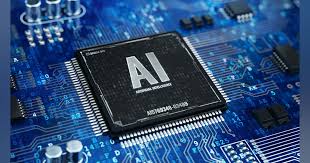AI in Chip Design
Science & Technology SciencePosted by NewAdmin on 2025-02-10 09:03:12 |
Share: Facebook | Twitter | Whatsapp | Linkedin Visits: 79

AI is transforming chip design by making the process faster, more efficient, and cost-effective. Traditionally, designing semiconductors required extensive simulations, manual adjustments, and years of development. AI accelerates this process by optimizing layouts, predicting successful design patterns, and automating complex tasks using machine learning. This speeds up innovation and enhances the performance of modern chips.
AI is also improving semiconductor manufacturing through process optimization, real-time defect detection, predictive maintenance, and energy efficiency improvements. AI-powered systems analyze massive datasets to identify inefficiencies, ensuring higher yield rates and reduced production costs. Automated quality control systems using computer vision detect microscopic defects with greater accuracy than human inspection, leading to more reliable semiconductor production. Furthermore, predictive maintenance allows manufacturers to anticipate equipment failures, minimizing downtime and increasing operational efficiency.
Another key benefit is cost reduction. AI-driven automation in chip design and manufacturing lowers overall expenses by improving efficiency and reducing waste. Studies suggest that AI integration in semiconductors can cut manufacturing costs by up to 17%, making chip production more affordable and competitive. Additionally, AI enhances energy management by identifying areas of energy waste and proposing optimizations, helping semiconductor companies reduce their carbon footprint and comply with sustainability goals.
As AI continues to evolve, its role in semiconductor design and manufacturing will become even more significant, driving innovation and ensuring the production of more powerful, energy-efficient, and cost-effective chips. This technological advancement positions AI as a central force in shaping the future of the semiconductor industry
Search
Categories
Recent News
- Hyderabad's Drug Bust: Unveiling a Complex Network
- Hyderabad's Fight Against Cybercrime: A New Approach
- Hyderabad Gears Up for Presidential Visit, Traffic to Be Affected
- Hyderabad's Traffic Transformation: A Multi-Agency Effort
- Digital India's Dark Side: Elderly and Vulnerable Targeted
- Hyderabad Gears Up for Christmas Feast: Traffic Diversions in Store
- Hyderabad's Homicide Surge: A City on Edge
- Hyderabad's Biryani Scam: When Food Delivery Meets Fraud
Popular News
- Navigating IPO Market Dynamics Amid Volatility and Regulatory Changes
- Innovative Green Practices and Environmental Initiative
- Massive Worldwide Microsoft Outage Disrupts Multiple Sectors
- తెలుగుదేశం పార్టీ - పేదరికాన్ని నిర్మూలించడంలో వాగ్దానం
- Universities Embrace Remote Learning Technologies Amidst Ongoing Pandemic